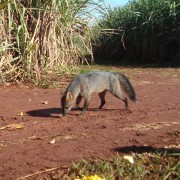Biodiversity
 Bush Dog
Cerdocyon thous | Linnaeus, 1766
Bush Dog
Cerdocyon thous | Linnaeus, 1766

Characteristics: Species measuring about 65cm in length and with a tail of about 30cm. The coat varies from gray to brown, with a stripe of black fur from the nape to the tip of the tail; its chest and belly are light-colored with black tips, and the fur is short.
Distribution: Throughout Brazil, except in low areas of the Amazon basin. Abroad, this species is found from Colombia to Paraguay and in Uruguay.
Habitat: Forests, savannas, fields, and disturbed areas, as well as areas inhabited by man.
Habits: Nocturnal and crepuscular species, generally solitary but seen in pairs during the breeding season. Bush dogs may be seen on road sides, where they look for the remains of animals that have been run over. Because of this behavior, they are often victims of run overs themselves.
Diet: Omnivore and generalist, feeding on small birds, small rodents and mammals, in addition to fruits, insects, crustaceans (river crabs) and eggs.
Breeding: The gestation period is 52-59 days, and 3-6 pups are born.
In the UFRA area: This carnivore species is frequent, as it was spotted numerous times. It was present in nearly all habitats, except exotic woods and fields in spontaneous regeneration. It is a well-established species in the entire sugarmill area, where it is well protected from hunters. There are many tracks in all habitats, and pups are seen often accompanied by adults, which is indicative of thriving population. The bush dog also makes good use of the crop areas for foraging and shelter, if necessary. This species was often detected in the sugarcane carrier tracks or sheltering in the crop's plots.










